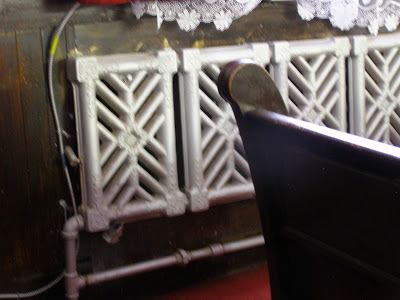 |
| Boston, MA. Former Adath Jeshurun, commonly known as the Blue Hill Avenue Shul, in its heyday as an active synagogue. Postcard. |
.JPG) |
| Boston, MA. Former Adath Jeshurun, commonly known as the Blue Hill Avenue Shul, Photo: Samuel D. Gruber 2013. |
.JPG) |
| Boston, MA. Former Adath Jeshurun, commonly known as the Blue Hill Avenue Shul, Historical marker placed by The Bostonian Society. Photo: Samuel D. Gruber 2013. |
Some of these buildings, erected mostly in the first quarter of the 20th century, are grand and were built as celebrations of Jewish life in America. Today they are all churches. Others are quite humble - they were transformed from private houses into little shuls (shtieblach), and today serve small Christian congregations. David Kaufman traced the history and architecture of many of these congregations in his important article "Temples in the American Athens: A History of the Synagogues of Boston," that first appeared in 1995 and was reprinted in J. D. Sarna, E. Smith, and S-M Kosofsky, eds., The Jews of Boston (New Haven: Yale University Press, 2005), 175-218.
.JPG) |
| Boston, MA. Former Adath Jeshurun, commonly known as the Blue Hill Avenue Shul, Interior view to Ark wall. Photo: Samuel D. Gruber 2013. |
.JPG) |
| Boston, MA. Former Adath Jeshurun, commonly known as the Blue Hill Avenue Shul, View from women's gallery. Photo: Samuel D. Gruber 2013. |
.JPG) |
| Boston, MA. Former Adath Jeshurun, commonly known as the Blue Hill Avenue Shul, remains of Ark wall, with Decalogue set before painted view of Mount Sinai. Photo: Samuel D. Gruber 2013. |
The building campaign for Adath Jeshurun began in 1904 and congregation macher David Krokyn set the architectural tone by engaging Fred Norcross as builder, and having his own son Jacob Krokyn, a 1905 Harvard School of Architecture graduate draw up plans. Krokyn, who died in 1960, went on to become a leading Jewish architect in Boston, and designed several synagogues and community buildings (see David Kaufman, Shul With a Pool, 264 ff.). The big two-towered building was finished in time for Rosh Hoshana in 1906. Kaufman quotes the account of the dedication in the Boston Advocate:
The edifice now dedicated is a splendid and imposing structure which will be for all time a monument to the self-sacrifice and religious fervor of this congregation. It is of brick, with stone trimming, and cost more than $100,000. It is finished in new oak and marble. The seating capacity is estimated at 1200. Besides the synagogue proper there are Sabbath school rooms and a large hall. The building is heated by steam and lighted by electricity..."
.JPG) |
| Boston, MA. Former Adath Jeshurun, commonly known as the Blue Hill Avenue Shul, Former bimah and duhan (Ark platform). Photo: Samuel D. Gruber 2013. |
Inside, however, the Blue hill Avenue synagogue would have been considered quite modern - by American Orthodox standards of the time. The congregation was associated, as already noted, with the Ramaz - one of the founders of Modern Orthodoxy. In 1906 the large impressive interior would have spoken to the congregation of a more modern, orderly form of worship. Today, there is no central bimah, but presumably an historic photo will reveal that there was one. But there is a large bimah-like platform attached in front of the Ark. Was this just the duhan for the priestly blessing, or were sermons delivered from here, too? The pews are large and placed in orderly rows - unlike the sometimes more individualistic arrangements in small shuls and study houses. I tried to imagine what the original configuration might have been - probably there was no central aisle, but rather two aisles leading to each side of the now dismantled bimah. Stay tuned - and we'll try to figure out the original arrangement.
The formality of the sanctuary is emphasized by the impressive use of columns and classical capitals, and the large stately arches above the gallery. Added to this are the modern mechanical features - good heating and electrical lights - not to be taken for granted at the time! Rabbi Mordechai Kaplan, later founder of Recontructionist Judaism, visited the synagogue in 1914 when his brother-in-law Phineas Israeli was rabbi. Kaplan noticed a split between conservatives and progressives in the congregation, but especially praised Israeli's innovative "junior congregation" established for young people.
.JPG) |
| Boston, MA. Former Adath Jeshurun, commonly known as the Blue Hill Avenue Shul, The chandeliers - still in place - were electrified from the start.. Photo: Samuel D. Gruber 2013. |
 |
| Boston, MA. Former Adath Jeshurun, commonly known as the Blue Hill Avenue Shul, Stairway to the women's gallery. Photo: Samuel D. Gruber 2013. |
.JPG) |
| Boston, MA. Former Adath Jeshurun, commonly known as the Blue Hill Avenue Shul, Mosaic floor in stair landing. Photo: Samuel D. Gruber 2013 |
 |
| Boston, MA. Former Adath Jeshurun, commonly known as the Blue Hill Avenue Shul, Original radiator in sanctuary. Photo: Samuel D. Gruber 2013 |
USA: New Haven's Orchard Street Shul (1925)
USA: Buffalo, New York's Oldest Synagogue Building Threatened with Demolition
USA: Olean, NY Synagogue Added to National Register
USA: Temple Beth Tefilloh in Brunswick, Georgia to Seek National Register Status



1 comment:
Hello. Do you have any idea where to find records of early members of the Blue Hill AVenue Synagogue? Thank you
Post a Comment